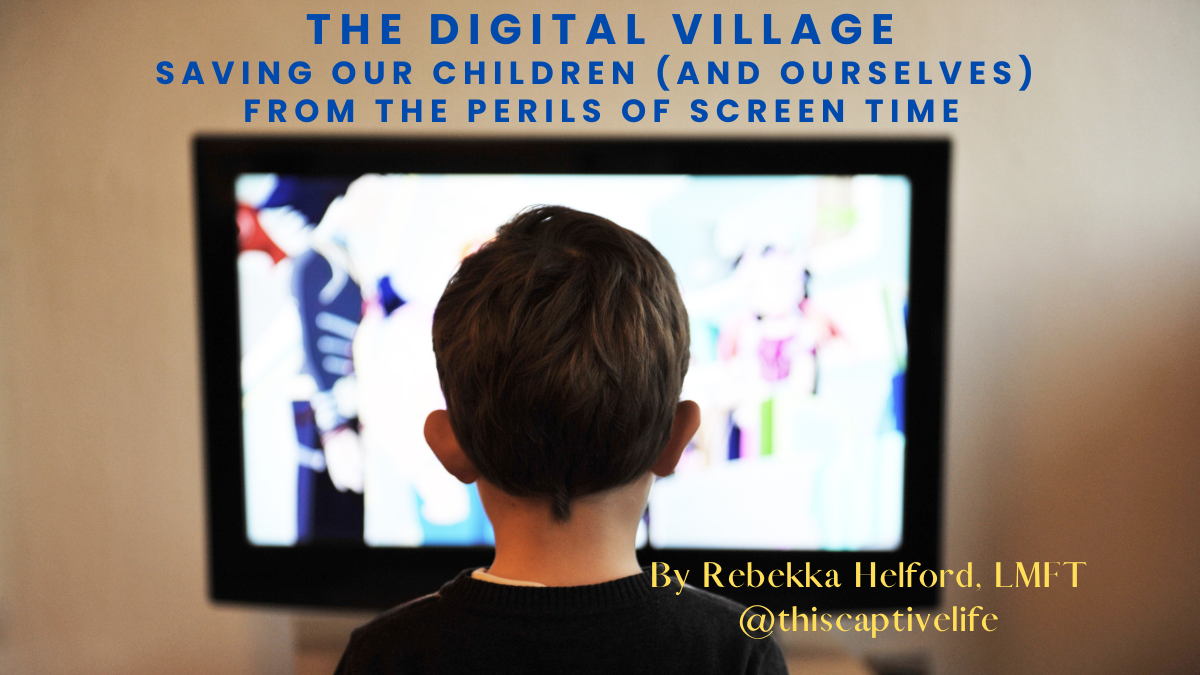The digital village: Saving our children (and ourselves) from the perils of screen time
In its most recent statement concerning young children's exposure to screen-based media, the American Academy of Pediatrics comes down pretty firmly on the subject. No screens before the age of 2 (with the exception of FaceTime), and beyond that, limiting daily time spent on screens, with a strong emphasis on parental curation of content and social consumption of screen-based offerings.
Many parents with whom I work feel understandably concerned and/or guilty about their children's screen time usage, wondering how to interpret these guidelines and think about them in a realistic, non-alarmist way.
Here's how I see it.
In the environment and time where Homo sapiens adapted, where our species spent over 95% of its time on this planet, we lived in small groups of hunter-gatherers. These groups were marked by, among other things, a ratio of approximately five adults to every child. This means not only that our species has evolved to expect five adult minds to hone and develop each child mind, but also that for the vast majority of our existence, we literally had a village to raise each child.
In many modern-day hunter-gatherer societies, although children are attached to their parents, this relationship is seen as much less central to a child's life; instead, each child develops formative relationships with many members of their surrounding community. In studying some of the still existing so-called "traditional" societies, anthropologists have observed newborns being exchanged to another adult's hands on average every 10 minutes, with some children barely leaving skin-to-skin or close proximate contact with a caregiver for the first 2 or more years of life.
For all the benefits of modern living (which I very much appreciate), our non-hunter-gatherer lifestyle is seriously lacking in the village-like community support that was integral to the survival and proliferation of our species.
In a very real sense, we have lost our village.
Enter screens: the new village. TVs and other screen-based media offer a potent mix of ingredients that are irresistible for us village-less modern humans with hunter-gatherer brains. First of all, media triggers our innate reflex to attend carefully to any sudden or new stimulus, a phenomenon known as the "orienting response." (If you've ever found yourself unable to stop glancing over at a TV in a restaurant, even though it's showing an infomercial for an industrial paint dryer, you have effectively demonstrated this artifact of our evolutionary heritage). Secondly, as we observe the social interactions of the characters in our favorite shows, screen-based stories play upon our hunter-gatherer impulse to get to know people and pay attention to compelling events. Via high-intensity storytelling, where the characters become substitutes for actual social relationships, screen-based media takes on the form of a supernormal stimulus: something that exponentially triggers a primal, life-giving urge.
To explain, in our ancestral habitat, certain behaviors conferred an evolutionary advantage, enhancing individuals' ability to get their genes into the next generation. Some of the most basic of such behaviors are eating, mating, and being social. As a result, actions that fulfill the urge to eat, mate, and be social feelgood, triggering the release of the reward chemical dopamine in the nervous system and prompting us to do it over and over again.
Fast forward to the modern world, where our stimuli related to eating, mating, and being social are pumped up on steroids. Nowhere in our evolution did we have access to foods so sweet, salty, or fatty, or to salaciously satisfying images of social encounters delivered on-demand with slick editing and storytelling techniques that make the one-arm bandit of our primitive brains turn up three cherries in a row every time. Supernormal stimuli are the opiate of the masses. In fact, since opiates (and all addictive substances, for that matter) are also a widely used supernormal stimulus of choice, opiates have effectively become the opiates of the masses as well. The same can be said for screen-based media.
Moreover, so are the screens themselves. Ever found yourself "just checking Facebook really quick" to find yourself still hunched over your phone in the dark 45 minutes later? The urge to keep scrolling and scrolling (fueled by the "infinite scroll" design choice) is triggered by our hunter-gatherer reflex to be insatiably curious about the unknown.
The addiction to dopamine triggered by the hedonic treadmill (the never-ending human pursuit of all-too-fleeting good feelings) is problematic in and of itself. A lifetime of screen exposure that starts early can change brain patterns related to attention and arousal that make it more difficult to cope with reality. But the issue at stake in this discussion is the fact that screen-based storytelling has become our digital village, a substitute for real relationships. When this happens for small children, they are deprived of valuable opportunities for social learning and language development/practice that screens simply can't replicate. Baby Einstein, the company with its dubious promise of making babies smarter through DVDs, which was successfully sued for making false promises, irreparably deprived many children of time their well-intended parents might have spent interacting with them socially. Research has shown that babies with early exposure to screens in lieu of actual social interactions have language delays, and studies have shown that babies cannot pick up salient cues about language (and thereby learn either their native language or foreign ones) through video.
So screens are our new village: the digital village. Our babysitters, wise elders, lifelong friends, and stories told around the campfire. They're certainly not harmless, but they are most definitely are here to stay. So, what's a concerned parent to do?
The way I see it, screens are a tool, like many other tools we use as parents.
As far as young children are concerned, we—their parents—decide when and how screens are used, and we are in charge of delivering them and taking them away (sort of like a "division of screen responsibility," taking after Ellyn Satter's "division of responsibility" related to food). This gets a bit more nuanced as children age, but the basic principles can be found in some of the most appropriately articulated family media agreements.
In addition to these basic parental duties, here are some other key areas to consider regarding children and screen-based media.
Curation Matters
Not all programming is created equal, and parents should be duly skeptical of content labeled "educational." A recent article by James Bridle about the terrifying algorithm-generated YouTube content aimed at children should scare any parent off of allowing their child to have unfettered access to the site. For a variety of curated "not made for kids but perfect for them" video gems, try The Kid Should See This instead. Common Sense Media provides a free database with comprehensive reviews (by both parents and kids) of nearly every show, movie, and video game you can think of, considering factors like age-appropriateness, presence of a variety of potentially disturbing or questionable thematic elements, and questions to discuss with your children afterwards.
Content created by PBS and Sesame Workshop continuously take the cake for thoughtfully created children's programming. Daniel Tiger's Neighborhood was designed to boost preschoolers' and their parents' social and emotional skills, and empirical studies have confirmed that the show lives up to its goals. Sesame Street is an old standby that's still delivering incredibly timely and appropriate content for children and their parents. My kiddo also likes Sarah & Duck, Puffin Rock, Storybots (available on Netflix), Bookaboo (available on Amazon Video), Charlie and Lola, Pixar movies, and music videos from a variety of genres (especially the kids' albums "Here come the 123s," "Here come the ABCs," and "Here comes science" (available on Amazon prime) by my favorite band, They Might Be Giants). Lately we've also been entranced by the magical world of Studio Ghibli, especially My Neighbor Totoro, Kiki's Delivery Service, and Ponyo, some of the more young-child-friendly members of this Japanese family of animated hits.
Connection Matters
Certainly, we all need to occupy our children sometimes in service of the greater good (read: taking a shower, visiting the toilet unaccompanied, or preparing a meal). Screens can be used as a tool in this way if you have no other options or tribespeople to help keep your kiddo occupied and safe. However, it's also important to bond with your child over screen-based programming. Build in some contingent, reciprocal communication (the kind children prefer and from which they learn best) to that screen encounter. Ask questions based on content ("What's Grover doing?" "Where is Daniel Tiger's shoe?"), the emotional states of characters ("How do you think Big Bird felt about not being able to play that game?"), or the sequence of events ("What do you think will happen next?"). Share inside jokes about programs you have enjoyed together. Do physical activities while you watch ("Let's dance like Elmo!"). Make up new stories and play out scenes about your favorite characters. Let the screen enhance your relationship, not detract from or serve as a substitute for it.
Choice Matters
I highly recommend that you choose something you can live with, not something that will drive you insane! Children don't have to have poor taste in content—with our skillful curation, as described previously, we can help steer our children toward original, charming, even beneficial screen-based media that doesn't make us want to poke our eyes out with a fork (and that we might actually enjoy too).
Timing Matters
Because screens emit light (specifically blue light), they send unconscious signals to the brain telling it to remain awake. This may affect our body's daily rhythms of waking and sleeping (known as circadian rhythms), delaying the release of the slumber-inducing hormone melatonin. For this reason, experts recommend keeping screens out of children's rooms and turning them off at least 1-2 hours before bedtime.
I also don’t recommend using screens at mealtimes, because eating together is, in many cases, the last bastion of real human contact in families. If a small child is getting wiggly during a meal at home, let them move around for a bit, sing a song together, or get silly! If you’re at a restaurant, be prepared in other ways (with toys, going for walks, ordering food in advance-don’t worry, for more tips, check out my post on taking toddlers out to eat!) and know that very young children may have a very hard time dining out until they cultivate the patience and appreciation for the experience.
Village Matters
Don't let the digital village be your only source of connection or support, no matter how powerful the appeal of its supernormal stimulus may be. Find a real village, when you can. Even if you don't have grandparents or other relatives around, get help. Join a local parent support group or weekly playgroup. Hire a nanny or a sitter. Do a childcare trade with a friend.
Do whatever it takes to build your community. To update the old saying, it takes a village to raise both children and parents alike.
Rebekka Helford is a licensed marriage and family therapist in private practice in Los Angeles, California. With over a decade of experience working with parents and young children, Rebekka specializes in short-term intensive parenting consultation, using a variety of tools including home, office, and school visits to help families navigate developmental hiccups and get back on track. Virtual visits now available!
Click here to schedule an appointment or contact Rebekka with a question – who knows, she might even answer it in her next post!


